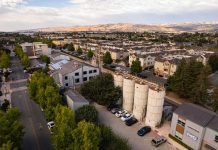Our interest in water stems from never-ending increasing costs
associated with groundwater. Santa Clara Valley Water District is
invited to respond to comments made.
Our interest in water stems from never-ending increasing costs associated with groundwater. Santa Clara Valley Water District is invited to respond to comments made.
SCVWD manages the wholesale water supply and flood control for 1.7 million residents of the county. SCVWD defines South County as the valley floor south of Metcaf Road to the county line.
It includes the Coyote and Llagas subbasin and its population of 100,000. Land south of Metcaf is designated by the district as Zone W5, while land north of Metcaf is Zone W2. These are the only two zones in the county, and they pay very different rates for water. Zone W5 groundwater rates are half that of the North.
Except for a handful of irrigation turnouts from the Central Valley Project (CVP) pipeline, South County water is pumped from the ground.
On a five-year average, total South County use is about 55,000 acre-feet a year. About 55 percent is used for agricultural purposes.
The remainder is dubbed municipal and industrial. That’s water for residential or business use. Of the 55,000 acre-feet, 14,000 acre-feet (five-year average) comes from the San Luis Reservoir that is part of the CVP.
CVP water is used for artificial groundwater recharge to the Llagas subbasin in the Morgan Hill Main Avenue, San Pedro and Madrone channel percolation ponds. The Madrone channel is the trench paralleling highway 101 on the east side.
The balance of South County’s 55,000 acre-feet is pumped from the subbasin. Natural recharge provides the bulk of the water. Natural recharge includes rainfall, seepage from hills, dams, pipelines and water returned to the basin from irrigation.
The water district views South County as not subsidizing North County, and that we are not paying our share for today’s services. The district already published plans for further price hikes. One of the large charges to South County is the price of imported water purchased on our behalf from the CVP (the 14,000 acre-feet).
San Luis Reservoir water was made available in the summer of 1987 at the completion of the San Felipe Division construction.
The main elements of the massive construction project included pumping stations, tunnels and the aqueduct connecting San Luis reservoir to Santa Clara County.
To help pay the cost of importing San Felipe water, district staff recommended in March 1986 that all South County users pay a new pump tax, beginning in July 1987. Prior to July 1987, individual residences with wells in the Gavilan Water Conservation District were not charged for water pumped from their wells.
You may remember the Gavilan district being dissolved in November 1987 on Measure G. Gavilan charged the City of Gilroy a modest, but now laughable, sum of $25 per acre-foot for ground water extracted by the city water works. It’s now $215.
In SCVWD’s fiscal year 1985/1986, construction was completed on the Cross Valley Pipeline, which would move both San Felipe water and water from Anderson reservoir up to Calero Reservoir.
The Cross Valley Pipeline connected with the CVP pumping station at the foot of Anderson, thereby completing the link to the Santa Clara Valley Aqueduct that stretches to the San Luis reservoir.
The Main Avenue and Madrone channel percolation ponds in Morgan Hill used to be supplied by Lake Anderson’s stored rainwater. Not anymore.
With the pipeline complete, SCVWD redirected Anderson water that helped to supply these ponds, and instead, sent it to North County via Calero Reservoir. Anderson and Coyote Lake water are mostly generated in a watershed located in South County.
It ultimately comes to this. A plan was engineered by SCVWD to get as many customers possible paying for CVP water and the San Felipe Division construction costs.
The district proceeded to turn off Anderson water for the Llagas subbasin recharge water, ship it north, and make the Llagas subbasin dependent on imported water.
It’s beyond strange that rainwater from the east hills of Morgan Hill, Gilroy and San Martin and stored in Coyote and Anderson reservoirs is not used for the needed recharge in the Llagas subbasin.
Shipping this local rainwater in Anderson to North County, only to turn around and buy imported water from the CVP for Llagas subbasin recharge, is just crazy.
It’s our belief that rain-water generated in South County for the Anderson and Coyote reservoirs, stay in South County. The excess can flow north for use in zone W2.
As a first step for a remedy, we suggest SCVWD supply 14,000-acre feet of Anderson and Coyote lake water to the Morgan Hill ponds, then turn off all South County CVP water and re-figure the groundwater charges. Future South County needs should be supplied by Anderson reservoir up to the limit of South County rainfall generated in the eastern hills.







